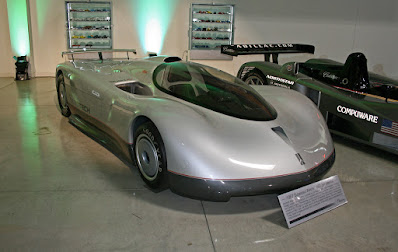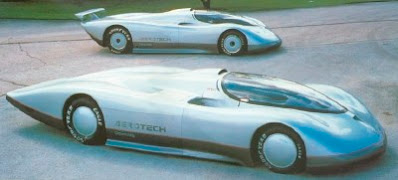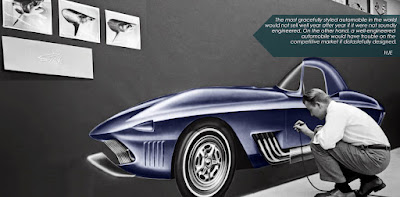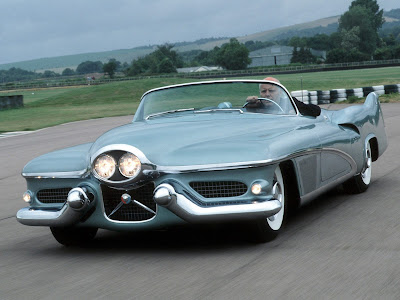Is it a bird? Is it a plane?
Well, it's something like that: A 1956 Firebird II turbine concept built by some of the most out-of-the-box thinkers from General Motors.
The 1950s were a golden era for futuristic cars, and none captured the optimism of the time quite like the 1956 Firebird II. Built by General Motors as part of its experimental Firebird series, the Firebird II was unveiled at GM’s Motorama show as a glimpse into the future of family transportation.
Unlike the radical single-seat Firebird I, which resembled a jet fighter on wheels, the Firebird II was designed as a four-passenger concept car. Harley Earl, GM’s legendary styling chief, envisioned it as a family vehicle of the future—one that would combine turbine power with aircraft-inspired design.
Although the Firebird II was never intended for production, it remains one of the most ambitious and advanced concept cars GM ever created. Today, it stands as a symbol of mid-century innovation and the bold spirit of Motorama
Firebird II Turbine Performance
At its core, the Firebird II featured the Whirlfire GT-304 gas turbine engine, a 200-horsepower powerplant capable of running on a variety of fuels such as kerosene, diesel, or jet fuel. Turbine technology fascinated GM engineers because it promised fewer moving parts, lower maintenance, and higher reliability compared to piston engines.
The Firebird II wasn’t just about raw power—it was about reimagining the future of driving. GM constructed the car’s body out of titanium, an incredibly strong and lightweight material rarely used in automobiles even today. The Firebird II also incorporated one of the boldest ideas of the 1950s: automated highways.
Engineers designed the Firebird II with sensors that could communicate with wires embedded in the road, allowing the car to guide itself automatically. This vision of self-driving cars was decades ahead of its time, proving just how forward-thinking the GM engineers were with this Firebird II.
A Wacky Appearance
The Firebird II looked nothing like an ordinary 1950s automobile. Its design borrowed heavily from jet fighters, with a sharply pointed nose, a sleek canopy roof, and pronounced tailfins that gave it an unmistakably futuristic look. The car’s wide stance and low profile emphasized aerodynamics, while four exhaust outlets at the rear showcased its turbine engine.
Where typical family cars of the 1950s were boxy and conservative, the Firebird II looked like it came straight out of a science fiction movie. Chrome trim, smooth lines, and space-age details made it a showstopper at Motorama and a visual icon of GM’s futuristic vision.
Complicated, Crazy Interior
Inside, the Firebird II continued its aviation-inspired theme. The cabin featured individual bucket seats for all four passengers, separated by a central console that ran the length of the interior. The controls and instrumentation resembled those of an aircraft, reinforcing the idea that the Firebird II was more machine than car.
The most striking feature was the wraparound bubble canopy, which gave panoramic views and bathed the interior in light. It wasn’t just about style—the canopy emphasized the futuristic experience GM wanted to deliver with the Firebird II, making every passenger feel like part of a space-age adventure.
Did You Know?
-
The Firebird II was the first turbine-powered concept car designed specifically as a family vehicle.
-
Its titanium body made it one of the most advanced material experiments of its era.
-
GM designed the Firebird II to operate on an automated highway system, an early vision of autonomous driving.
-
The Firebird II was fully functional and toured the country as part of GM’s Motorama exhibitions.
-
Today, the Firebird II survives as part of the GM Heritage Center collection.
If You Dream It, You Can Build It
The 1956 Firebird II was far more than a show car—it was a rolling vision of the future. With its gas turbine engine, titanium body, bubble canopy, and experimental automated guidance system, the Firebird II embodied the limitless imagination of 1950s America.
While turbine engines never replaced conventional power and automated highways remained a dream, the Firebird II showed how daring and innovative General Motors was willing to be. It remains a milestone in concept car history, admired not only for its futuristic styling but also for its ambitious technology.
In the end, the Firebird II wasn’t just an automobile. It was a dream machine—a bold experiment that pushed the boundaries of engineering and design, and a reminder of an era when the future of driving seemed as thrilling as the jet age itself.


















